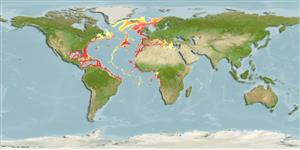Actinopterygii (ray-finned fishes) >
Gadiformes (Cods) >
Macrouridae (Grenadiers or rattails) > Macrourinae
Etymology: Nezumia: A Japanese word that means "mouse" .
Issue
This species is often confused with Nezumia sclerorhynchus (Valenciennes, 1838).
Environment / Climate / Range
Ecology
Marine; benthopelagic; non-migratory; depth range 200 - 2320 m (Ref. 3587), usually 200 - 1000 m (Ref. 2683). Deep-water, preferred 23°C (Ref. 107945); 70°N - 12°S, 98°W - 30°E (Ref. 1371)
Atlantic Ocean: Eastern Atlantic: Faroe Bank to northern Angola and the Mediterranean Sea. Western Atlantic: Davis Straits to northern Brazil.
Length at first maturity / Size / Weight / Age
Maturity: Lm 4.5, range 4 - ? cm
Max length : 36.0 cm TL male/unsexed; (Ref. 3587); common length : 25.0 cm TL male/unsexed; (Ref. 2683); max. reported age: 9 years (Ref. 58045)
Dorsal
spines
(total): 2;
Anal
spines: 0. Head short, completely scaled except for naked strip on the ventral surface of the snout; Eyes relatively large, 29 to 42% of head length; snout short, pointed; chin barbel very short. Body scales with lanceolate to shield-shaped spinules. Overall color is bluish to violet, head somewhat tawny to swarthy; ventral portions silvery when fresh; pelvic fins black except outermost ray which is pale to white; oral cavity grayish; branchial cavity mostly black.
Feeds on benthic as well as pelagic animals like mysids, amphipods, small shrimps, copepods, isopods, ostracods and polychaete worms (Ref. 6187).
Life cycle and mating behavior
Maturity | Reproduction | Spawning | Eggs | Fecundity | Larvae
Cohen, D.M., T. Inada, T. Iwamoto and N. Scialabba, 1990. FAO species catalogue. Vol. 10. Gadiform fishes of the world (Order Gadiformes). An annotated and illustrated catalogue of cods, hakes, grenadiers and other gadiform fishes known to date. FAO Fish. Synop. 125(10). Rome: FAO. 442 p. (Ref. 1371)
IUCN Red List Status (Ref. 115185)
CITES (Ref. 94142)
Not Evaluated
Threat to humans
Harmless
Human uses
Fisheries: minor commercial
Tools
Can't connect to MySQL database fbquizv2. Errorcode: Too many connections
